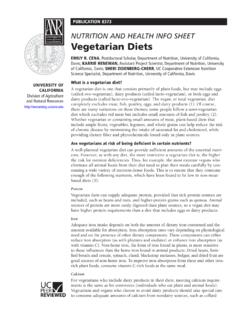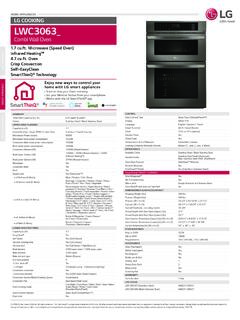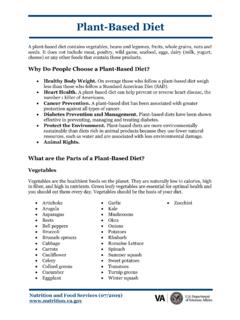Transcription of Peppers: Safe Methods to Store, Preserve, and Enjoy
1 PeppersSafe Methods to Store, Preserve, and EnjoyContent reviewed and revised by LINDA J. HARRIS, Food Safety and Applied MicrobiologySpecialist, Department of Food Science and Technology, University of California, have grown in popularity in recent years, and a wide variety are now availablein neighborhood grocery stores. Native to the Americas, most varieties belong to theCapsicum annuum species. Almost all peppers turn from green to yellow, orange, red,or purple when they are fully ripe. Green bell peppers are often harvested beforethey are ripe and are usually less expensive because they can better withstand trans-port and tend to last range in pungency from the sweet bell to the fiery habanero.
2 The chem-ical substance that makes some peppers hot is capsaicin (pronounced kap-'say-i-sin ). Each type of hot pepper has its own distinctive flavor and level of TIPS FOR PRESERVING PEPPERSIt is a common misconception that the hotter the pepper, the more acidic it is. Thehotness of a pepper depends on the amount of capsaicin it contains and not on thelevel of acidity. All peppers are classified as low-acid foods and have a pH of depending on maturity and pickling or canning peppers , it is important to follow recipe directionscarefully. peppers preserved improperly at home have caused botulism. Never tastefood that appears to be spoiled.
3 If the contents of the jar appear gassy, mushy, moldy,or have a disagreeable odor, discard the food carefully. Boil the jar, lid, and contentsfor 30 minutes in water. Thoroughly scrub all counters, containers, equipment(including can openers), clothing, and hands that may have come in contact withthe food or containers. Do not reuse sponges or towels that may have been used inthe cleanup. Place them in a plastic bag and discard it in the trash. If someone hasPUBLICATION8004 UNIVERSITY OF CALIFORNIAD ivision of Agriculture and Natural :The volatileoils in hot peppers cancause burns. When workingwith hot peppers it isadvisable to wear not touch eyes withcontaminated the early 1900s, Wilbur L.
4 Scoville devised a test todetermine the relative hotness of different from a known weight of pepper was extract-ed with alcohol and mixed to various concentrationswith sweetened water. Human tasters were asked todetermine the point at which the water neutralized thehotness. A rating (in Scoville units) was assigned basedon the volume of water required to neutralize the hot-ness. In the early 1980s this technique was replaced bya high-pressure liquid chromatography test that mea-sures the amount of capsaicin more of tradition these measurements are stillexpressed in Scoville UnitsHabanero_____100,000 to 300,000 Thai_____50,000 to 100,000 Cayenne_____30,000 to 50,000 Serrano_____5,000 to 15,000 Jalape o_____2,500 to 5,000 Poblano_____1,000 to 1,500 Cherry_____100 to 500 Bell_____0 Research on food preserva-tion is ongoing recom-mendations may sure your information is always current.
5 Alwaysfollow up-to-date, testedguidelines and recipes fromreliable questionable food and becomes ill, contact a doctor and the local healthdepartment immediately. If possible, save the jar of questionable food for health offi-cials to FRESH PEPPERSThe ideal storage temperature for fresh peppers is 45 F ( C), but they will lastabout 1 week in a typical home refrigerator (which should be at 40 F or C).Fresh, whole peppers will last longer if they are kept most fruits and vegetables, peppers should be washed just prior to con-suming or preserving. To wash, rinse well under clean, cold water, gently rubbing toremove dirt or soil.
6 Cut or chop on a clean surface using a clean knife. Any cut fruitsor vegetables (including prepared salads or produce platters) should be stored in therefrigerator if not used within 2 hours. Once cut, fruits and vegetables are very sus-ceptible to spoilage. Almost all cut produce can support the growth of microorgan-isms (including some pathogens) when stored at room PEPPERSP lain PeppersPeppers lose their crispness when frozen and thawed. frozen peppers are useful incooked dishes where texture is not important but the pepper s flavor is most vegetables, they do not require blanching before freezing. peppers canbe sliced or diced, quick frozen on a cookie sheet, and packed into moisture- andvapor-proof PeppersRoasted red bell peppers , popular in many recipes, can be prepared in advance andfrozen.
7 Anaheim peppers can also be prepared in advance and frozen for use inchiles To peel, first heat in a gas flame, on the barbecue, or under the broiler until theskins separate from the flesh. Then cover peppers in a bowl for 5 to 10 will slip off Remove stem and Flatten whole peppers to remove air, or cut peppers into strips or other conve-nient Pack prepared peppers into moisture- and vapor-proof packaging, excluding asmuch air as possible. A sheet of waxed paper or plastic wrap between pepperswill make them easier to handle when Label and freeze at or below 0 F ( C). frozen peppers will maintain theirquality for 9 PEPPERSP eppers can be sun-dried, air-dried, or dehydrated in a home dehydrator or finished product can be crumbled or powdered in a blender to use as a flavor-ing or coloring in many foods.
8 Soak dried peppers in water to rehydrate them for usein casseroles. Dried peppers can be stored in moisture- and vapor-proof packagingin a cool, dry, dark place for several : Safe Methods to Store, Preserve, and Enjoy2 Covering roasted peppersin oil and storing them atroom temperature is not asafe practice. It can lead tobotulism. Freezing is thepreferred method to pre-serve roasted on food preserva-tion is ongoing recom-mendations may sure your information is always current. Alwaysfollow up-to-date, testedguidelines and recipes fromreliable temperatures should be higher than 85 F ( C). If night temperatures dropenough to cause dew to form on the grass (dew point), bring the peppers peppers dry better if they are cut in half.
9 Remove seeds, stems, and mem-branes. Then slice or cut into cubes. Small peppers can be left whole but should beslit with a knife to speed drying. peppers are dried completely when air-dry peppers , first slit them with a knife. Then use a large needle to run a heavythread through the stems of the peppers . Hang the strings of peppers in a roomwhere the air circulates freely. High humidity can cause the peppers to spoil beforethey dry. This method can take as long as 3 to 4 or oven temperatures should not exceed 140 F ( C). Large peppersdry better if they are first cut in half. Remove seeds, stems, and membranes. Thenslice or cut into PEPPERSAll types of peppers can be pickled.
10 They are low in acid and must be properly acid-ified if they are to be safely processed in a water bath canner. The lower tempera-tures used in pickling help to preserve the crispness of the peppers . Follow recipedirections carefully (see General Instructions for Processing Pickled peppers in aWater Bath Canner )to ensure a safe, quality the Right EquipmentlSelect canning jars and lids as carefully for pickling as you would for jars in hot, soapy water, and rinse well. Discard jars with chips or use new lids. Ring bands can be reused, but replace those with dents water bath canner or deep kettle is necessary for processing.
















